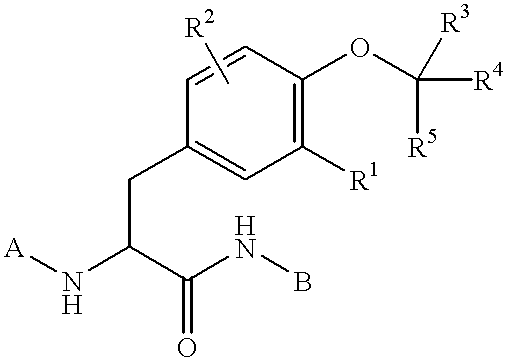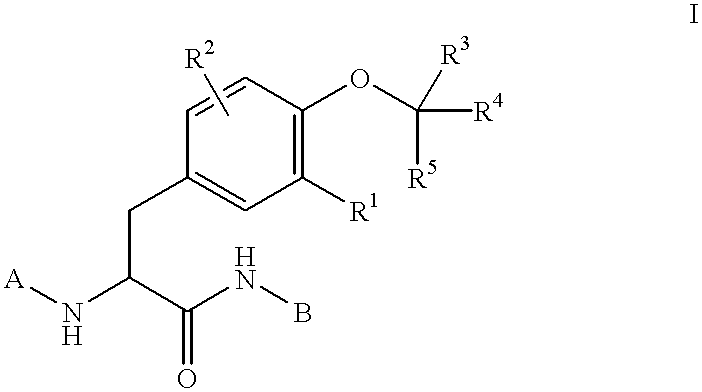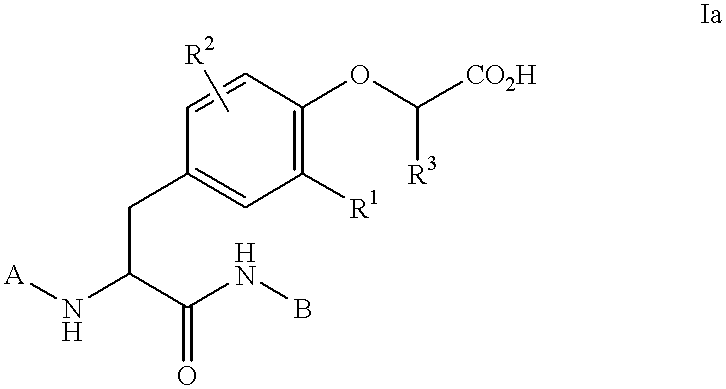Preparation of phosphatase inhibitors
a phosphatase inhibitor and phosphatase technology, applied in the field of preparation of phosphatase inhibitors, can solve the problems of unstable in vivo and inefficient cross-cell membrane crossing of compounds
- Summary
- Abstract
- Description
- Claims
- Application Information
AI Technical Summary
Benefits of technology
Problems solved by technology
Method used
Image
Examples
example 1
##STR13##
5-[(2S)-2-Benzenesulfonylamino-2-(4-methoxy-benzylcarbamoyl)-ethyl]-2-carboxymethoxy-benzoic acid (compound 1)
Step A: (2S)-2-tert-Butoxycarbonylamino-3-(4-hydroxy-3-iodo-phenyl)-propionic acid
Iodotyrosine (10 g, 33 mmol) is stirred in dioxane (100 mL) at 0.degree. C. 0.5 M NaOH (100 mL) is added and the mixture is stirred rapidly. Boc anhydride (7.8 g, 36 mmol) is added and the reaction is allowed to slowly warm to RT over 2 hours. The reaction becomes completely homogenous at this time. The dioxane is removed by concentration in vacuo and the aqueous solution extracted with EtOAc (2.times.100 mL). The aqueous solution is acidified to pH 3 with concentrated HCl. The mixture is extracted with EtOAc (2.times.100 mL) and the combined organics are washed with H.sub.2 O (200 mL) and saturated NaCl (200 mL). The organics are dried (MgSO.sub.4), filtered, and concentrated to provide 2-tert-butoxycarbonylamino-3-(4-hydroxy-3-iodo-phenyl)-propionic acid.
Step B: (2S)-2-tert-Butoxycar...
example 2
##STR30##
{4-[(2S)-2-Benzoylamino-2-(4-phenyl-butylcarbamoyl)-ethyl]-phenoxy}-(2H-tetrazol-5-yl)-acetic acid (compound 18)
Step A: (2S)-N-[2-(4-Hydroxy-phenyl)-1-(4-phenyl-butylcarbamoyl)-ethyl]-benzamide
Phenyl butyl amine (0.55 mL, 3.51 mmol) is added to a stirred solution of N-benzoyl-L-tyrosine (1.00 g, 3.51 mmol), PyBop (2.19 g, 4.21 mmol) and Hunig's base (0.73 mL, 4.21 mmol) in DMF (10 mL) at RT under N.sub.2. After 1 h, the reaction is diluted with EtOAc and the organic layer is washed with 10% HCl, water, saturated NaHCO.sub.3 and brine. The organic layer is dried (MgSO.sub.4) and concentrated under reduced pressure. The crude product is triturated twice with Et.sub.2 O and dried in vacuo to provide (2S)-N-[2-(4-hydroxy-phenyl)-1-(4-phenyl-butylcarbamoyl)-ethyl]-benzamide which is used without further purification.
Step B: Bromo-[2-(1-methyl-1-phenyl-ethyl)-2H-tetrazol-5-yl]-acetic acid ethyl ester
A solution of [2-(1-methyl-1-phenyl-ethyl)-2H-tetrazol-5-yl]-acetic acid ethyl es...
example 3
##STR45##
{2-Amino-4-[(2S)-2-benzoylamino-2-(4-phenyl-butylcarbamoyl)-ethyl]-phenoxy}-acetic acid, potassium salt (compound 33)
Step A: (2S)-2-tert-Butoxycarbonylamino-3-(4-hydroxy-3-nitro-phenyl)-propionic acid
Nitro tyrosine (20.0 g, 88.4 mmol) is stirred with Na.sub.2 CO.sub.3 (31.0 g, 292 mmol) in 1:1 dioxane:water (360 mL) for 15 min. BOC anhydride (21.2 g, 97.2 mmol) is added and stirring is continued for 14 h. The reaction mixture is diluted with water (1L) and extracted twice with Et.sub.2 O (2.times.250 mL). The aqueous phase is carefully acidified with concentrated HCl. The resulting yellow precipitate is collected by filtration and washed with water. The solid is dissolved in EtOAc (750 mL), washed with brine, dried (MgSO.sub.4) and concentrated under reduced pressure to provide (2S)-2-tert-butoxycarbonylamino-3-(4-hydroxy-3-nitro-phenyl)-propionic acid as a yellow solid.
Step B: (2S)-[2-(4-Hydroxy-3-nitro-phenyl)-1-(4-phenyl-butylcarbamoyl)-ethyl]-carbamic acid tert-butyl es...
PUM
| Property | Measurement | Unit |
|---|---|---|
| pH | aaaaa | aaaaa |
| insulin resistance | aaaaa | aaaaa |
| solubility | aaaaa | aaaaa |
Abstract
Description
Claims
Application Information
 Login to View More
Login to View More - R&D
- Intellectual Property
- Life Sciences
- Materials
- Tech Scout
- Unparalleled Data Quality
- Higher Quality Content
- 60% Fewer Hallucinations
Browse by: Latest US Patents, China's latest patents, Technical Efficacy Thesaurus, Application Domain, Technology Topic, Popular Technical Reports.
© 2025 PatSnap. All rights reserved.Legal|Privacy policy|Modern Slavery Act Transparency Statement|Sitemap|About US| Contact US: help@patsnap.com



